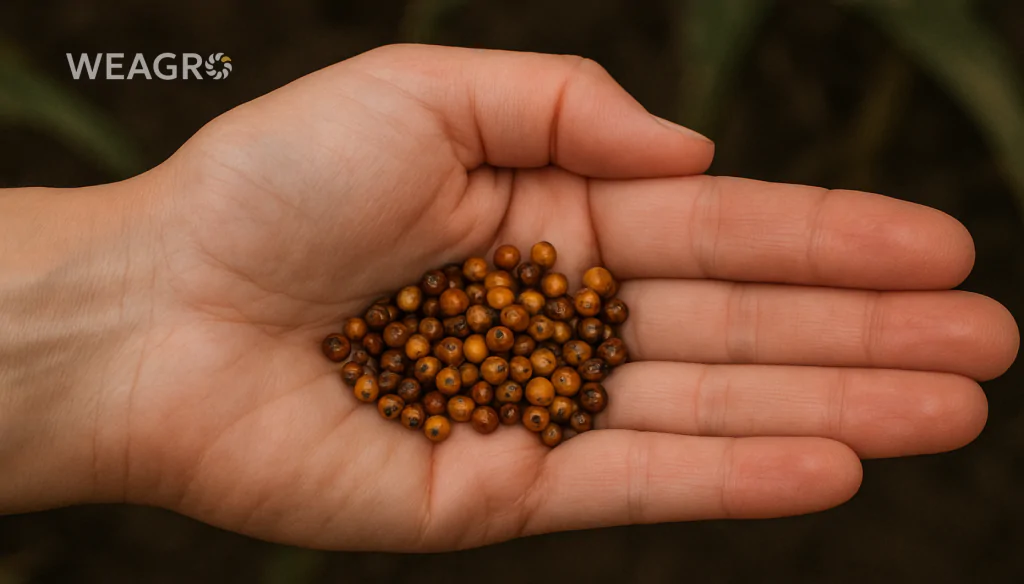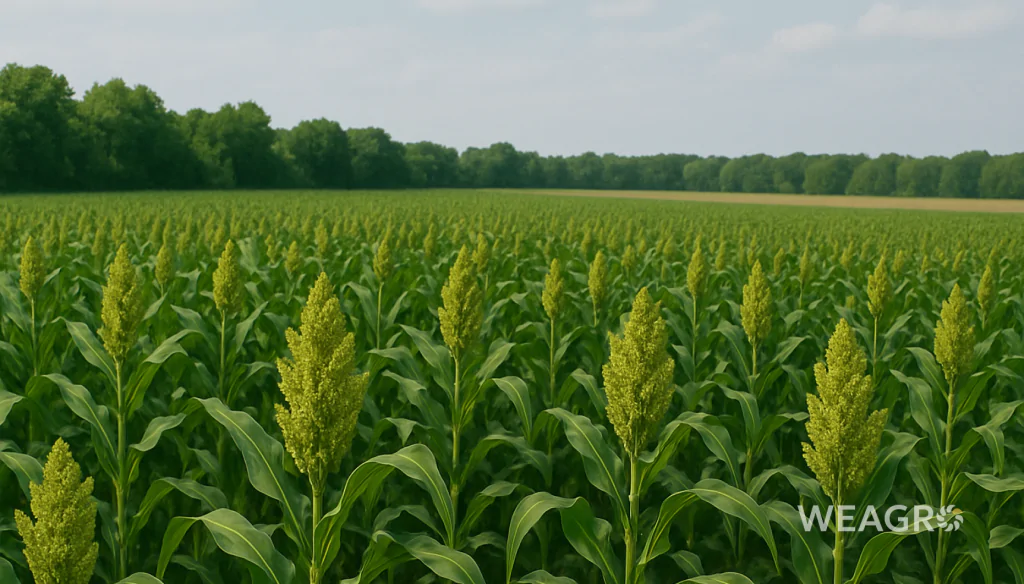Sorghum is a versatile crop that is rapidly gaining popularity among Ukrainian farmers. In recent years, our country has entered the top five largest exporters of the plant, supplying it to markets in Italy, Israel, and Spain. Although the crop’s planted area in 2023 was 13,900 hectares with 42,370 tons, the potential for growing this crop is far from exhausted. In this article, we will discuss the specifics of plant cultivation technology, seeding rates and varieties, and share useful advice from experts.
Sorghum: Crop Description
So, what is sorghum? It’s an annual cereal crop belonging to the Poaceae family. The plant has a powerful fibrous root system that penetrates to a depth of 2-2.5 meters. The stem is tall (up to 3-4 meters), straight, with well-defined internodes. The leaves are broad-linear, long (50-90 cm), with a waxy coating.
The inflorescence is a panicle containing 800 to 3,000 spherical or oval grains. The color can range from light yellow to dark brown, almost black. The weight of 1,000 grains is 20-30 grams.
Based on morphological characteristics and economic purpose, the crop is divided into four main groups:
- grain sorghum – used for grain production, which is used as livestock feed or for the food industry;
- sweet sorghum – characterized by high sugar content in stem juice (up to 20%), is valuable raw material for syrup, molasses, and bioethanol production;
- grass (Sudan) sorghum – grown for green fodder, hay, or silage;
- broom sorghum – used for making household brooms and brushes.
In Ukraine, grain and sweet sorghum occupy the largest areas – these are more drought-resistant and heat-tolerant plants compared to corn, so they can be grown in regions with unstable moisture.
Sorghum Yield
The potential yield of modern varieties and hybrids is quite high. Under conditions of sufficient moisture or irrigation, grain sorghum can form 8-10 t/ha of grain, while sweet sorghum can produce up to 100 t/ha of green mass or 60-80 t/ha of stems.
In rainfed conditions, yield strongly depends on rainfall during vegetation. With 200-300 mm of precipitation during the growing season, you can get 4-6 t/ha of grain or 30-50 t/ha of green mass. In more arid years, crop productivity will be lower, but still higher than corn or sunflower.
To realize the genetic productivity potential of modern varieties and hybrids, it is important to follow scientifically based elements of sorghum cultivation technology – this includes crop rotation placement, primary and pre-sowing soil cultivation, fertilization system, seed preparation for sowing, optimal timing and method of sowing, weed, pest, and disease control.
Read also: Sugar beet: sowing, yield, varieties and diseases
Sorghum Cultivation Technology
To obtain high and stable yields, it is important to follow key elements of sorghum cultivation technology adapted to the soil and climatic conditions of a specific region.
Sorghum: Growing Conditions
Sorghum is a heat-loving and drought-resistant crop that tolerates moisture deficit and high air temperatures well. Seeds begin to germinate at +8-10°C, seedlings can withstand frost down to -3°C. The optimal temperature for plant growth and development is +25-30°C.
The crop can be grown in all zones of Ukraine, but performs best in southern and eastern regions. Earlier maturing varieties and hybrids can be planted in the Forest-Steppe and Polissia regions.
The crop is undemanding regarding soil types. The plant grows well on chernozems, chestnut, sandy loam, and loamy soils. It can tolerate salinity and alkalinity. Soils with pH 6.5-7.5 are optimal for cultivation.
Sorghum: Sowing

Proper sowing is key to a good harvest. Let’s look in detail at what factors affect this process and how to obtain uniform and healthy seedlings.
When to Sow Sorghum
In Ukraine, it is recommended to sow sorghum when the soil temperature at a depth of 10 cm reaches +12-14°C. In the steppe zone, this usually coincides with the second half of April, in the forest-steppe zone – with the first half of May. Earlier sowing is only done in well-warmed soil. Summer sowings (after winter crops or early spring crops) are acceptable until mid-June.
Read also: Soil: what it is, types and its fertility
Soil Preparation for Sorghum Sowing
To obtain uniform seedlings, a carefully prepared seedbed is needed. Primary tillage is recommended in autumn, to a depth of 25-27 cm. In spring, moisture is preserved and the field is leveled.
Pre-sowing cultivation includes tillage to a depth of 5-6 cm. It is carried out 1-2 days before sowing. On heavy soils, rolling before sowing is also possible. If the soil is very compacted, additional loosening or disking at a depth of 10-12 cm may be necessary.
WEAGRO recommends using only organic fertilizers for fertilization. They will provide the soil with nutrients, improve its structure, and increase humus content. Manure, composts, green fertilizers, bacterial preparations are effective and safe for the soil. With the agricultural installment service, you can finance an organic nutrition system, save money, and obtain a clean ecological harvest.
Sorghum Predecessors
The best predecessors for sorghum are winter and spring cereals, legumes, and perennial grasses. It is not recommended to sow the crop after corn, sunflower, or sugar beets due to common diseases and pests. Repeated sowing is acceptable, but not earlier than 2-3 years.
Sorghum Seeding Rate per Hectare
The sorghum seeding rate per hectare ranges from 200,000 to 800,000 viable seeds. It depends on:
- maturity group of the variety or hybrid (early-maturing ones are sown more densely, late ones – less densely);
- sowing method (for wide-row sowing 45-70 cm, the rate is reduced by 20-30%);
- growing zone (sown less densely in arid conditions, more densely in sufficiently moistened conditions);
- seed quality (the lower the germination and sprouting energy, the more material needs to be sown).
Approximate rates in the Steppe and Forest-Steppe of Ukraine (million pcs/ha):
- early-maturing varieties and hybrids – 0.6-0.9;
- medium-maturing – 0.4-0.7;
- medium-late and late-maturing – 0.2-0.4.
Crop Sowing Method
Sowing is carried out by precision or wide-row method with row spacing of 45, 60, or 70 cm. The optimal row width is 45 cm, which provides better plant illumination and is more convenient for maintenance.
Seed burial depth on heavy soils is 4-6 cm, on light soils – 6-8 cm. During sowing, it’s important to ensure that the material lies on a firm seedbed and has good contact with the moist soil layer.
For sowing, precision (pneumatic, vacuum) or universal (grain, grain-fertilizer) seeders equipped with discs with 3-4 mm diameter holes are used. Sowing speed is 5-7 km/h. After sowing, the field must be rolled with ring rollers.
Sorghum Care

Seedlings develop slowly and are very sensitive to weed competition. Therefore, effective weed control is a key factor for successful crop cultivation. Both agrotechnical and chemical methods are used for control.
Agrotechnical measures include harrowing before and after emergence, inter-row cultivation in wide-row plantings. Pre-emergence harrowing with medium harrows is carried out 5-6 days after sowing. Post-emergence harrowing with light rotary harrows is carried out at the 3-4 leaf stage when plants are 10-12 cm tall. Inter-row cultivation with cultivators is carried out 2-3 times during vegetation at a depth of 6-8 cm.
For chemical protection of crops, soil and post-emergence herbicides are used. Soil preparations are applied before sowing or immediately after. Insurance herbicides are applied at the 3-6 leaf stage of the crop.
For nutrition, organic fertilizers should be used to the maximum extent. Rates and methods of their application depend on soil type, its fertility, and organic matter content. It’s best to apply well-rotted manure or compost during primary tillage in autumn. The rate is 20-40 t/ha. This will provide the soil with nutrients, improve its structure and water retention capacity.
Read also: Organic fertilizers: what they are, types and application rates
For foliar feeding, it’s better to use organic biostimulants and micronutrients of natural origin. These can be:
- preparations from seaweed extracts containing natural phytohormones, amino acids, vitamins;
- humic and fulvic acids obtained from leonardite or vermicompost;
- bacterial fertilizers containing nitrogen-fixing, phosphorus-mobilizing and potassium-mobilizing microorganisms;
- plant seed flour rich in natural microelements such as zinc, manganese, iron, copper.
Such preparations are environmentally safe, stimulate natural plant nutrition processes, and increase their stress resistance.
For crop protection against pests, insecticides are used, and for leaf diseases and root rot control – fungicides.
When to Harvest Sorghum
Grain sorghum is harvested by swathing or direct combining. In swathing, plants are cut into windrows at the wax ripeness stage of grain, which are picked up and threshed after 5-10 days. Direct combining is carried out when full grain ripeness is reached and moisture content drops to 16-18%. Threshing is done with minimal clearance between the drum and concave to avoid damaging and crushing the grain.
The harvest is immediately cleaned, sorted, and dried to 13-14% moisture content. Grain is stored in dry, ventilated storage facilities, preventing moisture and self-heating.
Sweet sorghum is harvested when the dry matter content in plants reaches 20-24%. Heads are cut at grain wax ripeness. Stems are cut with mowers, chopped, and ensiled. Silage is placed in trenches, thoroughly compacted, and hermetically sealed with film. The rate of preservative application is 3-5 l/t of raw material.
Millet and Sorghum: the Difference
The crops have many common morphological characteristics but differ in economic and biological properties. The main differences between millet and sorghum are:
- Sorghum has a more powerful and deeply penetrating root system, providing higher drought and heat resistance.
- Millet stem is thinner and less leafy. It is more suitable for making straw products.
- Millet has a spreading panicle, while sorghum has a compact or semi-spreading one.
- Millet seeds are smaller, with 1,000 grain weight of 5-12 g compared to 20-30 g in sorghum.
- Millet has a shorter vegetation period (75-115 days) than sorghum (90-150 days).
- Millet grain yield is 3-4 t/ha, green mass – 30-40 t/ha, which is lower than grain and sweet sorghum indicators.
- Millet grain contains more protein (12-16%) and less starch (50-65%), while sorghum has 9-13% protein, 60-75% starch.
Despite these differences, millet and sorghum have similar uses – for grain feed, cereal products, green fodder, silage. Both crops are undemanding to environmental conditions, resistant to drought and high temperatures. In Ukraine, they can be grown in all soil-climatic zones but are most common in the south and east.
Sorghum Varieties
Over 100 varieties and hybrids of different uses are under state variety testing in Ukraine. Grain and sweet types are most common in our country.
Main sorghum hybrids and varieties registered in the State Register of Plant Varieties of Ukraine:
| Name | Originator | Maturity group | Direction of use | Yield potential, t/ha |
| Dniprovskyi 39 | Synelnykivska EBS (IZK NAAS) | early-maturing | grain, food | 7.4 (grain) |
| Vinets | Henicheska ES (ISHSZ NAAS) | early-maturing | grain, feed | 6.7 (grain) |
| Dovista | Institute of Grain Farming NAAS | medium-maturing | feed, sweet | 90 (green mass) |
| Favoryt | Plant Breeding and Genetics Institute | medium-late | technical, feed | 3.28 (grain) |
| Medovyi | Plant Breeding and Genetics Institute | medium-late | silage, sweet | 53 (green mass) |
| Sylosne 42 | Synelnykivska ES | medium-late | silage | 76 (green mass) |
Most modern hybrids are simple interlinear ones created based on male sterility. They provide a grain yield increase of 20-30% compared to population varieties. However, for hybrids, it’s important to follow zonal agrotechnology, otherwise, the yield increase will be insignificant.
When buying seeds, it’s important to pay attention to their origin, reproduction, and quality. It’s better to use material grown in specialized seed farms and certified according to DSTU 2240-93. It has guaranteed indicators of varietal purity, germination, sprouting energy, and meets requirements for impurity content and moisture.
Read also: What is seed germination: definition, how to check
Conclusion
Sorghum is a promising crop for cultivation under climate change conditions. It can form stable yields at elevated temperatures and moisture deficit when other crops reduce productivity. However, to unlock the plant’s potential, it’s important to follow scientifically based cultivation technology, select adapted varieties and hybrids, optimize seeding rates, and weed control system.
Modern precision farming technologies, such as crop condition monitoring systems, differentiated application of fertilizers and plant protection products, as well as the use of weather monitoring data, can significantly increase cultivation efficiency and reduce environmental impact.
WEAGRO is your reliable assistant in effective and innovative cultivation. Get financial support through agricultural installment services to plan your crops using precision farming tools. With WEAGRO, the future of agriculture becomes reality today.









